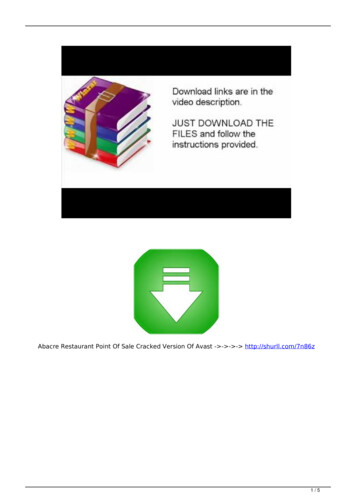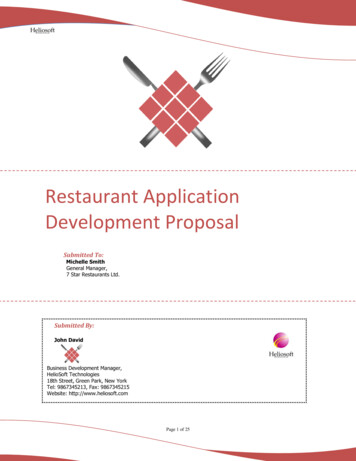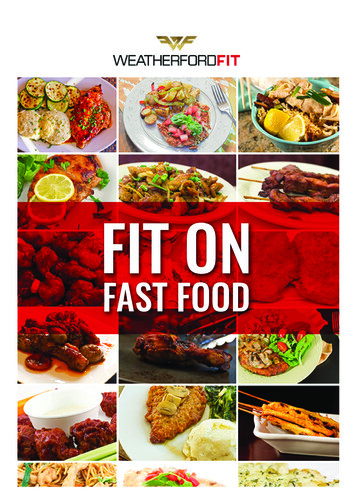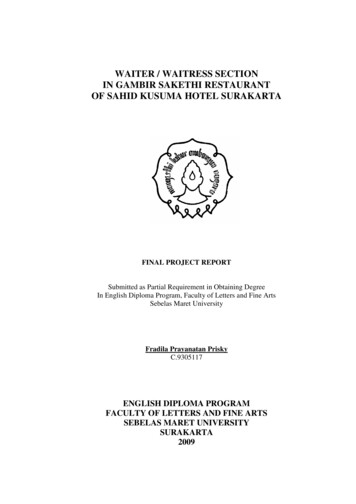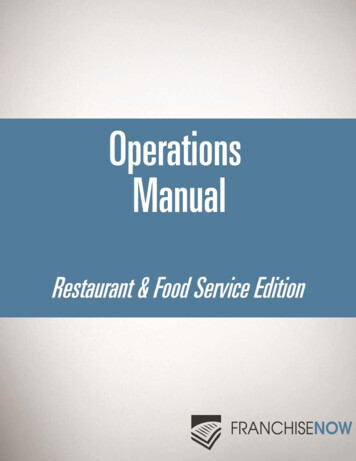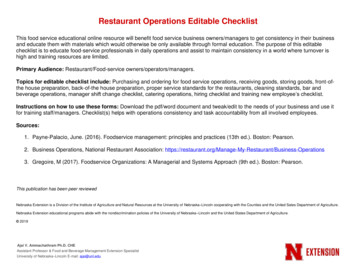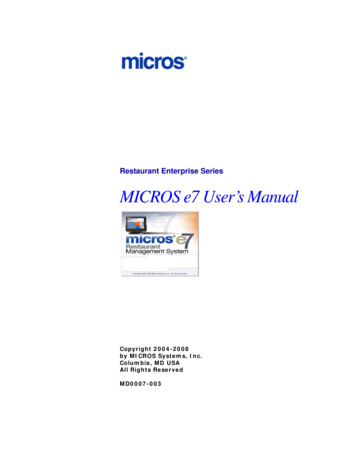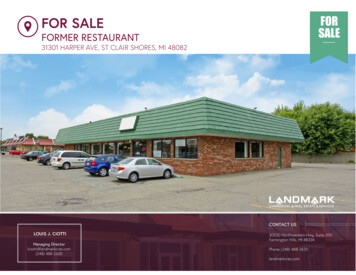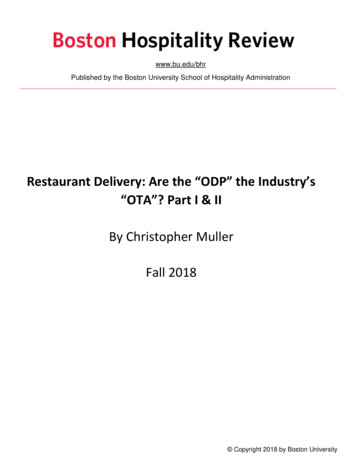
Transcription
www.bu.edu/bhrPublished by the Boston University School of Hospitality AdministrationRestaurant Delivery: Are the “ODP” the Industry’s“OTA”? Part I & IIBy Christopher MullerFall 2018 Copyright 2018 by Boston University
Part IThe entire restaurant industry, from the simplest quick service joint to the mostcomplex fine dining jewel, is caught in a veritable frenzy of delivery. It may be,unfortunately, a very risky path to travel for the uninitiated restaurant operation, butdelivery is driving the investment community to a fever pitch. [1] We have entered intothe time of the restaurant On-Line Delivery Provider (ODP) which mirrors in manyways the On-Line Travel Agent (OTA) which has so disrupted the lodging industry.In two complimentary BHR articles here, we present a look at the 8 different models ofrestaurant delivery and how they are affecting both senior management and customerchoices.A Quick Lesson From Pricing HistoryFor observers of the global Hospitality Industry this should send up warning flags. In agalaxy far, far away, the Lodging industry managed revenues by using simple seasonalor attribute pricing models (On-, Shoulder- and Off-Peak rates, or premiums for “ARoom With A View”) and sold some limited excess inventory through a network ofindependent Travel Agents (at an onerous 10% commission!).Then, as the Internet expanded, and the travel market imploded after the 9-11 tragedy, anew and exciting model emerged - the On-Line Travel Agent (OTA) acting as a thirdparty aggregator appeared. Hotel companies willingly gave open access to all of theirunsold room inventory to the OTAs (Expedia, Travelocity, Priceline, Booking.com,pg. 1
Kayak, Trivago, etc.) to sell directly at deep discounts, often between 25 and 30% offposted Rack Rates. Occupancies rose, but Average Daily Rates plummeted, and profitsquickly diminished. Hotels, relying on the old pricing models were caught competing“with themselves” and watched as formerly loyal customers switched their buying habitsand loyalties to the OTA that gave them the best rate. Customers could scroll throughpages of prices, often for the exact same room in the same hotel, searching for thecheapest rate. Hotel rooms, instead of being unique destinations becameinterchangeable commodities.It has taken almost twenty years, but through brand consolidation and a total systemwide transformation into a Revenue Management based pricing model, the hotelbusiness has been transformed and the OTAs are being aggressively challenged fordominance. This should be a lesson for the restaurant owner/operator, the OTAs drovenothing but price as a decision attribute, the ODPs are poised to do the same thing withboth price and convenience, unfortunately restaurants probably won’t have decades torecover.Today’s Restaurant Delivery Frenzy –The Rise of the ODPWhether it’s the savvy but shape-shifting Millennial, the rapidly aging Baby Boomer, orthe rising young digital native from the i-Generation, it seems that customers in allshapes and sizes just want to have their meals brought to them at home, the office, orsomewhere in between. Breaking the code of the delivery model—becoming thecustomer’s choice of who serves up breakfast, lunch or dinner at home, work or play—has emerged as the Holy Grail of the foodservice business. But it may be more like theother mythic Dark Ages metaphor, the Plague, potentially killing upwards of 30% ofexisting restaurant units.So, what exactly is “delivery” today, how did it evolve into such a big, expandingcomponent of the restaurant offering and what are the implications going forward forthe industry? Just how do the On-Line Delivery Providers, the ODP, dominate themarket?We can begin by agreeing that delivery is a distinct and rapidly growing distributionchannel, although it has been around in one form or another for a very long time. Andwhile not exactly a new technology, nor necessarily a profitable one, the explodingmarket for the delivery of food is poised for an inevitable shake out as it quicklyapproaches a mature phase consolidation.[2]In late 2018 delivery is all about instant gratification, not just for the diner but somewould suggest for the restaurant as well. At first glance, it all feels so simple and easy.But like so much in restaurant management, there is more than one way to getsomething done, even the simplest of things.pg. 2
Emerging Key Success FactorsLike so many emerging business models in the on-line digital age, food delivery isdeveloping its own metrics and factors to be considered and mastered. While stillevolving, among these now are: Addressing the profit challenges of “The Last Mile” in the delivery chain Minimizing the high cost of Customer Acquisition Developing an integrated APP, website, tablet and smartphone ordering platform Designing the most effective delivery driver fleet system Establishing an attractive and competitive user fee basis Creating positive and immediate Brand recognition Building a proprietary Knowledge Base of data storage, analytics and accessDelivery of food, especially from a restaurant to a consumer, has become a multi-billiondollar segment of the industry. Some are predicting that it will overtake the traditionaldine-in segment completely within a decade, although the complexity of getting it rightand turning a profit while doing so, can still be elusive even for the largest players. Andof course, no one should forget that Amazon is over in the corner waiting to see howthings evolve in an online delivery world they basically invented.pg. 3
Traditional and ControlledAs noted, the delivery of food from a restaurant directly to a local customer is not a newidea although traditionally the customer came to the restaurant and picked up or carriedout their food order. Both delivery and carry-out were best suited to a restaurant with asimple, easily transported menu. Where a significant amount of the value of the mealwas the dining experience and table service, meals to go were often comprised of apackage of leftovers or the long gone term “doggie bags.”Here is a look at four models with some measure of control for restaurant owners andoperators over the quality and profitability of their offerings.1. The Independent - One ShotAs a service provider a restaurant may decide that in order to meet the needs of its localcustomer base it should provide a delivery option. At one time, only a few restaurants inan urban core would have delivery offers and these might typically be delicatessens orChinese restaurants with few seats and a very strong focus on offering takeout options.The food can be cooked, boxed, wrapped and brought quickly to an office or apartmentwithin a few blocks on foot or by bicycle.This model is the most basic - a caller, the kitchen, and an employee bringing hot fooddirectly to the customer. The restaurant controls the quality, manages the relationshipwith the diner and absorbs the full cost and all the revenues. It typically comes withhigher operating costs for labor (primarily from an in-house paid delivery driver fleet)and with premium rent from the need for an attractive customer-facing retail space. Onpg. 4
the plus side, all local customer information may be controlled by the restaurant andthere are no fees to share with an outside third-party service.But as the independent operator reaches for the brass ring on the delivery merry-goround, they also need to be careful not to lose their grip on their existing ride. A newdistribution channel can be much more challenging that just taking a customerorder. As noted by Jennifer Marston: restaurants are under pressure to adapt More and more, that means alteringthe physical restaurant space so it can better accommodate this influx of neworders. Extra meals require extra bodies to cook and package the food, after all,not to mention extra space for third-party devices, and somewhere to putcompleted orders waiting to be picked up by a delivery driver.[3]An interesting twist on this single restaurant model of trying to find a way to bothcontrol and expand the delivery system while maintaining some measure of profitabilityis one recently proposed in the restaurant trade magazine Restaurant Business Online:He (CMO Nabeel Alamgir) explained that Bareburger is already striving toconvert customers ordering through third parties’ apps into users of thechain’s own channels. Patrons of an Uber Eats or Postmates might be offered a10% discount on their next order if it’s placed through Bareburger’s website. Thechain can afford a discount that deep because the financial impact is still lessthan the 20% or 30% discount an outside service typically charges.Alamgir noted at the start of the panel’s presentation that a service started byrestaurants for restaurants would have been an attractive alternative to some ofthe third-party giants. “Let’s make our own platform. Let’s make our ownGrubhub,” he said.[4]pg. 5
2. The Cloud Kitchen - A Hub & Spoke SystemIt can be argued that today’s focused delivery channel began in earnest when Domino’soffered up a “30 Minute or Free” guarantee in 1973. In order to make this guaranteeeffective, the company created a hub and spoke system, in effect building a series offranchised units in low cost locations. They were characterized by being geographicallymarket-centered but with no need for a “High Street” customer facing address. This wasdirectly in contrast to the overwhelming market advantage owned by Pizza Hut and itsnetwork of “Red Roof” full service pizzerias with their focus on dine-in and takeoutservice. But the competitive advantage that came from having units with no dine-in,limited customer carry-out, and which were serviced by a central commissary set inmotion the shift away from the traditional eat-in model.“The reality is, when the red roof restaurant was created, the idea of deliverywasn’t part of the concept,” said Pizza Hut chief executive David Gibbs, a 26-yearveteran at parent company Yum Brands ”so in many cases, our business hasoutgrown the capabilities of those restaurants ”[5]Now, four decades later Domino’s is the world leader in delivery, pizza or otherwise. Ithas done this by controlling the entire process or what is called the “full stack” in thedelivery cycle. Now describing itself as an IT and logistics company that sells pizza, thebackbone of the system is that they control the customer ordering process, theproduction quality process, and through a vast franchise network the delivery process.Next to come, using new GPS and AI technologies, Domino’s predicts that it will be ableto make deliveries not just to a formal building address, but to anywhere a customer canbe located by tracking their cellphone, even if that is a park bench or a blanket on thebeach.But Domino’s is not the only leader to be expanding its Cloud Kitchen delivery system.Already designed on a commissary production system model, giant fast casual leader,Panera Bread, tested delivery in Boston and then announced an expansion across theUnited States in early May, 2018 with a system based upon using its own deliverydrivers. [6] Following the trend in October the largest chicken sandwich chain, Chickfil-A, announced it was beginning to test the hub and spoke model of delivery inNashville, TN and Louisville, KY.Chick-fil-A is opening two new restaurants that don’t have something youcommonly associate with the chain: seats.Chick-fil-A, the Atlanta-based chicken sandwich chain, is testing catering anddelivery locations in Nashville and Louisville, Ky., that will open this month.The locations, according to an announcement on the chain’s website, have nodining rooms or drive thru’s and are designed to be hubs for catering and deliveryorders. The restaurants will not accept cash, either.[7]The Cloud Kitchen model can be very effective for restaurant companies with largeenough scale, whether in a single city or across a region, to take advantage of a singleproduction kitchen site with remote staging kitchens. Ultimately the “full stack” controlfrom order to front door can come from as few as three restaurants or as many as 3000.pg. 6
This also means that the foundation is laid for vast proprietary customer data collectionand eventually data mining by the most forward-looking operators.It can be argued that the Food Truck movement of the past decade is a subset of theCloud Kitchen model. By most local health code laws, food trucks must have a “homekitchen” or commissary for their bulk production that meets all health and sanitationcode requirements. In many urban centers, to be successful a food truck company needsto have multiple trucks on the road acting as a distribution network. While this is also aclassic Hub & Spoke model, it comes with similarities to a model in the next article, #6The Consolidator, with distribution on a bus stop route and not a one-to-one last miletaxi route.3. The Ghost KitchenOne further refinement of the Cloud Kitchen is the Ghost Kitchen. As delivery becomesmore of a threat to the traditional dine-in restaurant option, some suggest that thismodel, in fact, is the future of restaurants—basically a highly efficient hybrid of menuconcepts, specialized production and logistics, and low labor cost with no eat-incustomers.In that way, this model is identified by three key components.First, it removes the dining room or takeout from the restaurant completely, workingout of a kitchen whose location is based on nearness to its core customer market yet in atypically low rent out-of-the-way space.pg. 7
Second, it does not hire any paid employees to deliver, instead making use (throughpartnership or agreement) of the many third-party delivery companies like GrubHub,Postmates or Doordash.Third, and possibly the most important, because of the flexibility of only needing anAPP, website or traditional telephone ordering system, more than one cuisine can beproduced in the same kitchen space. Easy to prepare, cook an
Designing the most effective delivery driver fleet system . Now, four decades later Domino’s is the world leader in delivery, pizza or otherwise. It has done this by controlling the entire process or what is called the “full stack” in the delivery cycle. Now describing itself as an IT and logistics company that sells pizza, the backbone of the system is that they control the .

